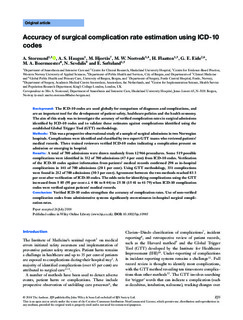| dc.contributor.author | Storesund, Anette | |
| dc.contributor.author | Haugen, Arvid Steinar | |
| dc.contributor.author | Hjortås, Magnus | |
| dc.contributor.author | Nortvedt, Monica Wammen | |
| dc.contributor.author | Flaatten, Hans | |
| dc.contributor.author | Eide, Geir Egil | |
| dc.contributor.author | Boermeester, Marja A. | |
| dc.contributor.author | Sevdalis, Nick | |
| dc.contributor.author | Søfteland, Eirik | |
| dc.coverage.spatial | Norway | nb_NO |
| dc.date.accessioned | 2019-01-10T14:34:24Z | |
| dc.date.available | 2019-01-10T14:34:24Z | |
| dc.date.created | 2018-10-08T11:31:11Z | |
| dc.date.issued | 2018 | |
| dc.identifier.citation | Storesund, A., Haugen, A. S., Hjortås, M., Nortvedt, M. W., Flaatten, H., Eide, G. E., . . . Søfteland, E. (2018). Accuracy of surgical complication rate estimation using ICD-10 codes. British Journal of Surgery. | nb_NO |
| dc.identifier.issn | 0007-1323 | |
| dc.identifier.uri | http://hdl.handle.net/11250/2580245 | |
| dc.description.abstract | Background
The ICD‐10 codes are used globally for comparison of diagnoses and complications, and are an important tool for the development of patient safety, healthcare policies and the health economy. The aim of this study was to investigate the accuracy of verified complication rates in surgical admissions identified by ICD‐10 codes and to validate these estimates against complications identified using the established Global Trigger Tool (GTT) methodology.
Methods
This was a prospective observational study of a sample of surgical admissions in two Norwegian hospitals. Complications were identified and classified by two expert GTT teams who reviewed patients' medical records. Three trained reviewers verified ICD‐10 codes indicating a complication present on admission or emerging in hospital.
Results
A total of 700 admissions were drawn randomly from 12 966 procedures. Some 519 possible complications were identified in 332 of 700 admissions (47·4 per cent) from ICD‐10 codes. Verification of the ICD‐10 codes against information from patients' medical records confirmed 298 as in‐hospital complications in 141 of 700 admissions (20·1 per cent). Using GTT methodology, 331 complications were found in 212 of 700 admissions (30·3 per cent). Agreement between the two methods reached 83·3 per cent after verification of ICD‐10 codes. The odds ratio for identifying complications using the GTT increased from 5·85 (95 per cent c.i. 4·06 to 8·44) to 25·38 (15·41 to 41·79) when ICD‐10 complication codes were verified against patients' medical records.
Conclusion
Verified ICD‐10 codes strengthen the accuracy of complication rates. Use of non‐verified complication codes from administrative systems significantly overestimates in‐hospital surgical complication rates. | nb_NO |
| dc.language.iso | eng | nb_NO |
| dc.publisher | John Wiley & Sons Ltd | nb_NO |
| dc.rights | Navngivelse-Ikkekommersiell 4.0 Internasjonal | * |
| dc.rights.uri | http://creativecommons.org/licenses/by-nc/4.0/deed.no | * |
| dc.title | Accuracy of surgical complication rate estimation using ICD-10 codes | nb_NO |
| dc.type | Journal article | nb_NO |
| dc.type | Peer reviewed | nb_NO |
| dc.description.version | publishedVersion | nb_NO |
| dc.rights.holder | © 2018 The Authors. | nb_NO |
| dc.subject.nsi | VDP::Medisinske Fag: 700::Klinisk medisinske fag: 750 | nb_NO |
| dc.source.pagenumber | 1-9 | nb_NO |
| dc.source.journal | British Journal of Surgery | nb_NO |
| dc.identifier.doi | 10.1002/bjs.10985 | |
| dc.identifier.cristin | 1618631 | |
| cristin.unitcode | 203,3,0,0 | |
| cristin.unitname | Avdeling for helse- og sosialfag - Bergen | |
| cristin.ispublished | true | |
| cristin.fulltext | original | |
| cristin.qualitycode | 2 | |

